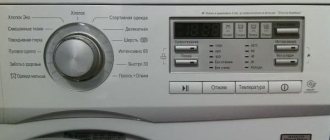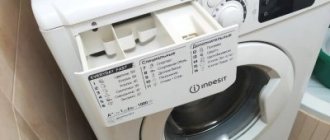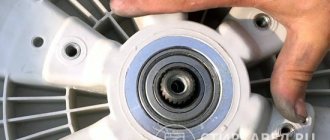While the washing machine works without failures, few people are interested in its structure.
But as soon as household appliances break down and do-it-yourself repairs are planned, detailed information about where individual elements are located and how they work will help carry out the work competently, quickly and efficiently.
We will tell you about the design of Indesit washing machines in the article.
Let's list the main elements
The washing machine device includes both main and additional modules. Your unit will only work if all components are in smooth contact with each other. A car of any model contains:
- electric motor;
- tank and drum;
- drain pump;
- control panel with electrical module support;
- spring shock absorbers;
- special unit with bearings;
- the main body, the rear wall of which is made in the form of a hatch cover;
- liquid intake valve;
- tubular electric heater and parts for it.
Please note that this is a completely basic set of parts for any washing device. If you understand what and how the circuit works, you can easily analyze the behavior of your Indesit washing machine.
Features of units with vertical loading
Top-loading washing machines have most of the parts the same as front-loading models: tank, drum, motor, shock absorbers, etc.
Top-loading washing machines have some design features
The body of such units is equipped with a hinged lid through which laundry is loaded. The drum is mounted on two bearing units and has flaps (many units are equipped with a self-positioning sensor, which ensures that the flaps stop exactly opposite the top cover). The control panel is usually located on the far side at the top of the case.
Many units of this type do not have a rubber sealing collar, since the design features of the tank and drum (with a hole at the top) practically eliminate water leakage through the lid. For the same reason, forgotten laundry can usually be added to such a washing machine throughout the entire wash cycle.
We hope that our article will help you learn more about a home assistant.
How does the technology work?
The Indesit washing machine is equipped with a plastic tank. To avoid deformation of the tank, it is not so rigidly connected to the body so that excessive vibrations are not created, which destroy the tank. After all, the tank moves very actively during washing and, especially, spinning, but the body remains motionless, which actually ensures the safety of the tank. Plus, two shock absorbers are placed below for support, and springs are placed on top.
During washing, the drum rotates thanks to a special pulley to which it is connected through a cross. The pulley, in turn, receives revolutions transmitted by the electric motor through a belt drive. All these actions cause the pulley to rotate, and since it is attached to the drum, the drum also rotates, due to which our clothes are washed. The drum itself is built inside the tank with a mount.
The so-called “intelligence center” of the washing machine is the control board; it is it that sets the sequence of operations and the coordinated interaction of all components of the unit. For example, supplying a washing machine with water includes a number of actions of different parts: the inlet valve draws water from the water supply, the heating element heats it to the required temperature, the pressure switch controls the volume of water, and a special pump removes contaminated water after the washing process is completed.
Now you can roughly imagine how your washing machine works and how it works, but to add more details, you should look at the operation of each module separately.
How does the washing process work?
Let's take a step-by-step look at the washing process in an automatic washing machine, and find out what parts are responsible for what when performing this operation:
- At the initial stage, water is collected. It comes through a special inlet hose located at the back of the device and connected to the water supply. The pressure switch controls the amount of water collected. In modern models there is a sensor that independently calculates the amount of water for a certain weight of laundry placed in the drum. This saves electricity and water. Our separate post is devoted entirely to the topic of how much water an automatic washing machine consumes in one wash.
- The washing begins. During the entire operation, water is constantly collected and a small amount is drained. A valve that opens and closes using a modular unit is responsible for supplying water to the device during washing. The pump located at the bottom of the device is responsible for draining.
- Before the drain there is a filter that collects all the debris: dirt, sand, buttons and a lot of other debris. It is advisable to clean it every two or three washes. It closes with a panel that can be easily opened with your fingers.
- At this stage, the heating element is turned on, which is located under the tank and is responsible for heating the water to a certain temperature. The device contains a device that monitors this indicator.
- At the end of the main wash, a spin program follows, causing the drum to rotate at high speed.
- Finishing the wash. After the program ends, you cannot open the device window for three minutes. However, after this time, you will be able to remove and hang the laundry.
Important! Unfortunately, there are times when it is easier to buy a new washing machine than to repair an old one. This may be due to both the cost of repairs and the lack of spare parts. In this case, our article “Where to put an old washing machine?” will be useful to you.
Main container and drum
Drums are predominantly made of stainless steel, as are the tubs of some washing machines. This material is more durable and, as a result, your machine will last much longer. However, if you prefer a more budget-friendly and lightweight option, take a machine with a plastic tank. It is not as durable, but it is cheaper and easier to carry. In the most common models, the tank is located horizontally, although some manufacturers also produce machines with inclined tanks.
All modern Indesit washing machines are equipped with plastic tanks.
So, the tank is the main capacity of any washing machine. As we already understood, there is a built-in drum into which you load your laundry. The drum usually has a huge number of holes through which water from the tank penetrates into this container. Yes, water is drawn from the water supply into the tank, where it is heated and mixed with the powder, and enters the drum during the washing process. In addition, the surface of the metal tank is very corrugated, which improves the quality of washing. To avoid leaks and other troubles, no foreign objects should get into the tank.
Country of origin of the Indesit washing machine: where are the assembly centers for household appliances located?
The history of the development of the Indesit brand began in Italy at the end of the twentieth century. Together with the famous Ariston brand, Indesit has achieved incredible results in the sales of washing machines and is the fourth largest manufacturer of household appliances in Europe. Today, Indesit brand washing machines are produced in various parts of the world: France, Poland, Ukraine, as well as in our country.
You can determine the location of assembly of the washing machine directly in the shopping center and using the appropriate markings in the device passport and on its body.
- The best models of Indesit washing machines 1. Indesit BWSA 61051 - an automatic machine with a rational volume
- 2. Indesit IWSB 5085 with traditional standards
- 3. Indesit WIUN 81
- 4. Indesit WISN 82 - enlarged copy
- 1. Indesit EWD 71052 - bestseller
Despite such ramifications of production workshops, uniform standards apply for the assembly of washing machines that meet the high quality of the equipment and, of course, optimal parameters that support operational safety.
One of the best-selling washing machines from Indesit are multifunctional vertical models.
Heating the mixture of water and powder
A tubular electric heater, or abbreviated as a heating element, which is built into the lower part of the machine, is responsible for heating the water in the tank. When the washing machine is actively used, the heating element is subject to the greatest damage, because scale forms on its surface, which gradually disables it, and, in addition, the heating elements always fail faster than other electrical appliances. The more often you wash in hot water, the faster problems will arise with the heater.
According to the technical characteristics, it is worth saying that the energy consumption is approximately 1800-2200 W. This is equal to the average energy consumption of any heating mechanism. Therefore, if it seems to you that the washing machine “eats” a lot of energy, then the problem is clearly with the heating element.
Main components of a vertical machine
To repair a washing machine with your own hands, you need to understand how the mechanism works and how the parts of the machine are interconnected. Such knowledge will help localize the problem without wasting time examining and diagnosing nodes that clearly have nothing to do with it. Indesit automatic top-loading machines are equipped with:
- top cover;
- side panels;
- tank with drum;
- control panel, behind which the main module is located;
- an electric motor responsible for rotating the drum;
- water supply valve;
- garbage filter;
- drain pump;
- heating element;
- a pressure switch that determines the water level in the tank;
- a tachometer that records the number of revolutions;
- counterweight and shock-absorbing springs;
- detergent dispenser;
- drive belt and pulley.
The main components of a vertical washing machine are the same as in the front washing machine. Having understood the washer circuit and the functions of each element of the machine, it will be easier for the user to understand what exactly went wrong and in which part of the system the failure occurred. The loading hatch for the “verticals” is located on the top cover, and the control panel is also located here. This is very convenient, since the user does not have to bend over to put laundry in the drum and set the desired program.
What makes the drum move?
Remember we already talked about the connection between the drum, pulley and electric motor? It is the electric motor that powers the device. Indesit uses commutator motors in order to save money and, as a result, to reduce the cost of goods. However, commutator motors do not have any enviable strength, and in addition, they are very susceptible to voltage drops, so it is better to connect them through a stabilizer.
Brushed motors quickly lose their level of functionality, and eventually stop working altogether if they are not carefully maintained (you will have to, for example, change the brushes regularly).
Water supply and removal
Water is supplied from the water supply to the tank according to this scheme.
- A specialized module “orders” the intake valve to open;
- The valve opens, and since it is under high pressure, water immediately begins to penetrate into the tank.
- The pressure switch controls the volume of water so that exactly as much as is needed (the same happens when draining water, so this sensor is indispensable for any machine);
- When the required volume has been reached, the pressure switch signals the module, and it, in turn, signals the valve that there is enough water and needs to close.
- The valve closes and the water supply stops.
As soon as the wash is completed, the control module begins to interact with the pump. The pump receives a signal to drain water and begins to push it into the sewer through the drain hose. Thus, water is pumped out from the tank. Then, using the same operations, the machine draws in water to rinse the laundry, and then drains it in the same way.
Preparation
Before you begin any repairs, you need to make sure you have the necessary tools. You may need:
- a set of flat and Phillips screwdrivers;
- socket and open-end wrenches;
- set of heads and knobs;
- hammer;
- multimeter;
- bit;
- hacksaw for metal;
- pliers;
- WD-40 product;
- awl.
To disassemble a washing machine, you may need a variety of tools.
Please note that the presented list of tools and tools is as wide as possible and allows you to perform any repair. In some cases, you can get by with a much smaller set.
You must understand that troubleshooting can take more than one day, and the removed parts will take up a lot of space. Therefore, if possible, move the unit to a garage, shed or any other utility room, where it will not be in the way, and spare parts can be neatly laid out.
Before disassembling the automatic machine, find the warranty card and make sure that the warranty period has expired. Remember that the manufacturer is not responsible for equipment that was repaired at home, so if the warranty is still in force, contact a specialized service center.
If there is no free space, organize the work on site: prepare a section of the floor at least 2 x 2 m in size, removing carpets, furniture and covering it with film or old newspapers. Disconnect the washing machine from all communications and carefully disconnect the hoses.
It is imperative to drain the remaining water from the tank so that during disassembly it does not get on other parts. To do this, place a dry cloth under the machine, unscrew the drain filter and wait until all the water drains from the hole. Also remove the detergent tray (usually to do this you need to press the latch located in the middle and at the same time pull the part towards you) and set it and the filter aside.
In order to disassemble a washing machine, certain skills are required. If you are not confident in your own abilities, it is better to entrust the work to professionals.
So, the Indesit washing machine is ready for disassembly, what should you do first?
The “brain” of the washer
The control board is responsible for all parts of the machine, except for the control panel (it includes all the buttons, indicators, etc.). There is a separate fee for this. Both of these devices are combined and perform the function of the “intelligence” of the machine: they issue commands to the modules for the coordinated operation of the device.
Washing programs and modes are pre-designed algorithms for certain actions that are recorded on the control board. Accordingly, it is responsible for the operation of any program that you choose. The board structure consists of many semiconductor elements (these include triacs, thyristors and other parts).
Contacts between parts are made through special electrically conductive tracks, which are also located on the control board.
The control panel board has a slightly different purpose. While the control board coordinates the interaction of parts, this one coordinates the interaction between the operator and the control board. That is, its task is to “explain” to the control board what exactly the user wants to do, as well as inform him about all the details of the wash (by displaying information on a special screen or through indicators).
Indesit washing machine circuit diagrams
Household appliance repair specialists claim that the circuit diagrams of Indesit washing machines are in many ways similar to the circuit diagrams of Ariston appliances. Some parts are even interchangeable. At the same time, there are certain differences between the models. Therefore, for each of them the manufacturer develops its own circuit.
It’s good if you have at hand a drawing of the machine you are going to work with. Also, a circuit diagram of the device’s electronics will not be superfluous. It is especially necessary when the control module needs to be repaired.
Auxiliary elements
We have figured out how the basic parts of the Indesit washing machine work. However, there are many more. Their role is not so fundamental, but without them your washing will not happen either. Here is their list.
- Parts that prevent the harmful effects of vibration on the tank are springs and shock absorbers. They dampen vibration.
- To prevent water from flowing out from under the hatch cover, there is a special cuff. This is a kind of rubber seal that tightly seals the hatch when washing.
- Hatch blocking device - abbreviated as UBL. This detail also helps to completely close the hatch and prevent accidental or independent opening. As long as the UBL is in good working order, water will not pour out of the machine.
- Drive belt. The one that directs the rotation to the pulley, and the pulley, as you remember, helps rotate the drum. Therefore, for the drum to operate, you cannot do without this part.
- Counterweights. Counterweights are very large stones, both in volume and weight, that are installed inside the body, increasing its mass. Due to these parts, the machine has the ability to resist centrifugal force during spinning. Otherwise, the washing machine would move very actively around the room due to pressure on the side walls.
- Hatch door. There is no need to describe the significance of this detail. Without it, washing is basically impossible.
- Powder receiver. There you place detergent and conditioner, which are dosed into the tank during the washing process. As a rule, it includes three compartments for different types of detergents.
- Pipes. Through them, water moves into and out of the tank. Built into the body.
Now, knowing all the details of the operation of the Indesit washing machine and the features of its design, you can easily analyze its behavior and condition. If a problem occurs, you will know what to look for first, and you will probably be able to carry out simple repairs yourself. Remember that if you treat it with care, your device will last you much longer and will delight you with its quality much more.
Interesting:
- Washing machine with vertical or front…
- Design of Bosch washing machines
- Dimensions of a front loading washing machine
- Best top loading washing machine
- How to disassemble a Zanussi washing machine
- How does an Electrolux washing machine work?
Reader comments
- Share your opinion - leave a comment
Do-it-yourself mechanical repair of the Indesit washing machine
Mechanical failures can be simple, which can be resolved in a couple of minutes, or complex, requiring disassembly of the case and replacement of components. Here are the most common malfunctions of Indesit machines and how to fix them yourself:
Increased vibration and jumping
If, during the spin cycle, Indesit begins to jump and move from place, then the reason may be in the directional distribution of the laundry or overload. To eliminate this phenomenon, it is necessary to stop the device when there is no water in it, wait until the hatch is unlocked and transfer things inside the drum. If the load is heavy, you can remove something and start the wash again.
Even increased vibration occurs due to an uneven floor, for which the machine is equipped with twist-out legs. The sagging corner is set on a level with the rest so that the body does not swing. You can finally check the evenness with a bubble level or a plate of water placed on the housing lid.
If the problem appeared immediately after purchase, then repairing the Indesit jumping washing machine with your own hands is done by unscrewing the transport bolts located on the rear wall of the case. When installing household appliances on tiles or laminate, you should place a rubber mat or small circles to prevent slipping.
If all of the above is done, but the machine continues to jump during the spin cycle, then the reason lies in loose shock absorbers. Over time, they stretch and no longer dampen vibrations properly. To solve the problem, turn the body on its side and remove the springs. They are attached with simple hooks, so DIY repairs are quite possible. To replace, it is worth choosing the correct length of the new shock absorbers. Parts from other machines will also work - the main thing is that the parameters match.
No water supply
Periodically, Indesit washing machines do not draw water, while all the buttons work, but when the program starts, the washing does not start. Here, the repair is performed at the inlet, where the supply filter in front of the tap or directly at the entrance to the housing is clogged.
To get to the first one, you will need to turn off the water in the house and unscrew the filter block in front of the tap that leads the water supply branch to the machine. Often rust and deposits from the system accumulate there.
Cleaning the filter of the Indesit washing machine with your own hands requires unscrewing the flexible hose connected to the back of the case. There is a fine steel mesh that traps residual debris. With prolonged use, the throughput drops and water stops flowing. Having removed foreign particles, the unit is assembled and the wash is started again.
Leaks on the front panel
Another common malfunction of this Italian brand of household appliances is water leakage on the front panel. This often occurs after carelessly removing laundry from the drum, when hard elements (large buttons, fasteners, metal decorations sewn to clothing) cling to the rubber cuff and tear it. Because of this, the tightness of the hatch cover is broken and water flows out.
When the leak is found, repairing the Indesit washing machine with your own hands is done by disconnecting the cuff clamps and twisting this place to the top, where the water pressure is less. The hole can be sealed with a rubber patch and “Moment”.
Stagnation of water in the drum
Sometimes in household appliances of this Italian brand, water remains in the drum. The washing program cannot be completed because it is not possible to spin. A common cause is the accumulation of debris in the drain filter. Do-it-yourself repair of this part of the Indesit washing machine involves stopping the washing program and disconnecting the unit from the network. Next you need:
- Remove the plastic decorative cover from the bottom of the housing.
- Behind it there is a plug for emergency drainage of water. Due to the low height above the floor, you will need a basin with low walls and a rag. Substituting the container, the plug is unscrewed and the liquid is drained. This can be done in doses, periodically screwing it back to collect water from the floor.
- There is a filter on the back of the plug. It comes in the shape of a cone with catcher ribs or a cylinder with mesh walls. Garbage from clothes and items forgotten in pockets accumulate here. Due to the narrowing of permeability, water stagnates, which leads to breakdown.
- Having removed all the excess, the plug is returned to its place and rinsing is started to check the permeability of the system.
If after this water continues to accumulate in the drum, then the blockage may be located higher in the pipe. It is L-shaped and connects the tank to the filter. After prolonged use, large objects also collect there (underwires from bras, pen caps), on which smaller ones are placed, which leads to clogging. The plastic corrugated tube is secured with two clamps, but to get to it you will have to turn the machine on its side. Having removed and cleaned the channel, everything is returned to its place and tested by drawing and draining water.
Pump jamming
When water remains in the drum and the pipe and drain filter are cleaned, the cause of the breakdown may be jamming of the pump impeller. This is accompanied by an uncharacteristic hum of the pump during pumping, the inability to drain water, and even the smell of burnt wiring. Here you can repair the Indesit washing machine with your own hands by disassembling the drain filter and shining a flashlight into the channel further.
The pump impeller looks like four plastic blades on an axis, the rotation of which forces water into the drainage pipe. With the appliance unplugged, carefully check the rotation of the element with your finger. So, you can find the blocking object (often small coins or buttons), take it out and return everything to its place.
Bearing failure
The most serious mechanical failure is the failure of the bearing on which the drum rotates. When exposed to moisture or after a long service life, the lubricant in it dries out, which leads to the disintegration of the internal parts of the assembly. This is accompanied by a metallic grinding sound and poor rotation of the drum.
Repairing the bearing of an Indesit washing machine with your own hands complicates the hard-to-reach location of the part. To replace it you will need:
- Remove the top cover of the machine.
- Disconnect shock absorbers and springs.
- Pull the drum out.
- Treat its landing site with WD
- Try to knock out the bearing. Masters have special devices for this, so if it doesn’t work, it’s better to contact them.
- When the bearing has been knocked out, the new one is carefully lubricated and put in place by lightly tapping the side around it.











